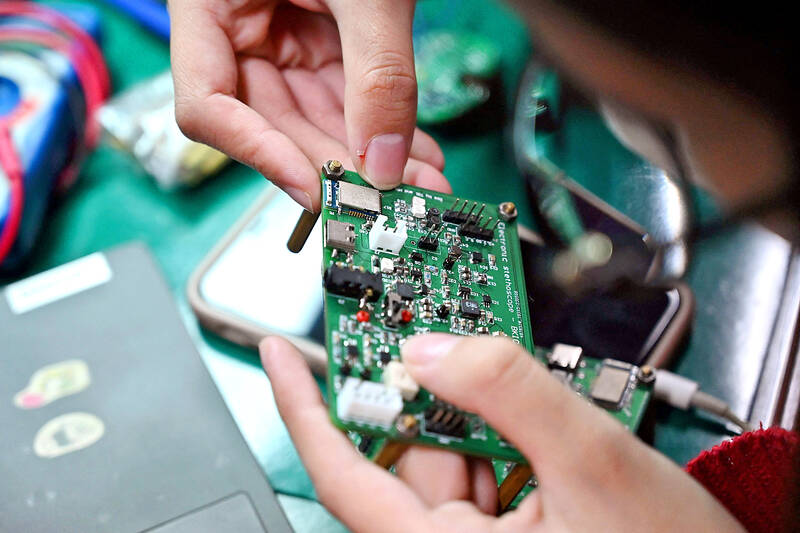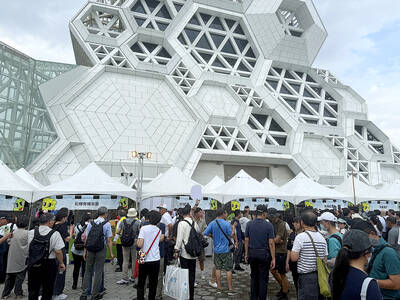Nguyen Phuong Linh is among a crop of young electronics students crucial to Vietnam’s ambitions to become a chips hub.
She’s driven, smart and already has her sights set on a professorship — wanting to train a new generation that could help woo foreign investors eager to diversify semiconductor production away from China and Taiwan.
Long viewed as a low-cost destination to make clothes, shoes and furniture, Vietnam is now eyeing a rapid climb up the global supply chain and has put computer chips at the heart of its development plans.

Photo: AFP
It is a goal that suits nations such as the US — increasingly worried about economic tensions with Beijing — but there are huge hurdles to overcome, chiefly a shortage of highly skilled engineers.
“Chips are attracting so much attention... among both the government and the public,” Linh said, while working in a tiny windowless lab at Hanoi’s University of Science and Technology, crowded with computers.
“I used to dream of working as a chip designer but now I want to be a professor. I think our country needs more teachers to create a better workforce,” the 21-year-old said.
RELATION-CHIPS
Vietnam’s market for semiconductors, which are used in everything from smartphones to satellites and to power AI technology, is expected to grow at 6.5 percent a year, reaching US$7 billion by 2028, according to Technavio, a market research firm.
During a visit to the capital last year, US President Joe Biden announced deals to support Vietnam’s chips industry, and shortly after, Nvidia — an American giant in the sector — said it wanted to set up a base in the country.
South Korea’s Amkor and Hana Micron both opened packaging factories last year in Vietnam, which is already home to US firm Intel’s largest factory for assembling, packaging and testing chips.
As the hype around Vietnam’s emerging chips industry ramps up, its communist government has said the country’s current pool of around 5,000 semiconductor engineers must jump to 20,000 in the next five years — and to 50,000 over the next decade.
Earlier this month, Deputy Prime Minister Tran Luu Quang made an official request to the CEO of South Korea’s Samsung, asking the electronics giant to help.
Vietnam is currently producing just 500 qualified engineers per year, according to Nguyen Duc Minh, a professor of integrated circuit (IC) design who teaches Linh.
“We need to do much more to reach the target,” he said. “I think this is a very challenging figure.”
BRAIN DRAIN THREAT
Many electronics students already know what role they want to play in the semiconductor field, with Linh’s classmate Dao Xuan Son eyeing a job at Intel.
But the pathway Vietnam’s leaders want to take is less easy to understand, according to Nguyen Khac Giang, visiting fellow at the ISEAS-Yusof Ishak Institute in Singapore.
“Do they want to achieve a national champion Samsung-like Vietnamese company in semiconductors, which requires a lot of capital and investment?” he asked. “Or do they simply want to attract more investment in the semiconductor business in Vietnam?”
Experts also seem unclear about how the government arrived at the 50,000 engineer figure, and whether they are needed for chip design or factory work.
“We talk of a very huge number but it seems we have not looked to see whether the industry really needs that big number of graduates,” IC design professor Pham Nguyen Thanh Loan said.
Intel said their focus in Vietnam would remain on assembly and testing, the lowest-value part of the semiconductor supply chain.
“We face a challenge in expanding our talent pool beyond these areas,” said Kim Huat Ooi, vice president in manufacturing, supply chain and operations, and general manager of Intel Vietnam.
Several universities launched additional programs this academic year that focus on semiconductor and chip design. But more importantly, professors say, Vietnam needs to invest in quality training that allows students to gain practical skills demanded by the world’s top firms.
Although courses are often good on theory, “we need more investment in infrastructure and equipment for students to practice,” Minh said.
Among those top graduates who do come through, there is “real risk” of brain drain to the world’s top chip-making nations, said analyst Giang.
“Let’s be honest, the salary in Vietnam is quite low, even for those with very high skills,” he said. “They might get the feeling... it’s probably better to just move to Taiwan.”
Linh said she is keen to study abroad to gain better connections to industry, but she is set on returning home.
Final year student Son, however, dreaming of a design position with Intel, would be happy to study and then stay overseas for a few years.
“I can learn more — and have more opportunities — outside Vietnam,” Son said.

Following the shock complete failure of all the recall votes against Chinese Nationalist Party (KMT) lawmakers on July 26, pan-blue supporters and the Chinese Communist Party (CCP) were giddy with victory. A notable exception was KMT Chairman Eric Chu (朱立倫), who knew better. At a press conference on July 29, he bowed deeply in gratitude to the voters and said the recalls were “not about which party won or lost, but were a great victory for the Taiwanese voters.” The entire recall process was a disaster for both the KMT and the Democratic Progressive Party (DPP). The only bright spot for

Water management is one of the most powerful forces shaping modern Taiwan’s landscapes and politics. Many of Taiwan’s township and county boundaries are defined by watersheds. The current course of the mighty Jhuoshuei River (濁水溪) was largely established by Japanese embankment building during the 1918-1923 period. Taoyuan is dotted with ponds constructed by settlers from China during the Qing period. Countless local civic actions have been driven by opposition to water projects. Last week something like 2,600mm of rain fell on southern Taiwan in seven days, peaking at over 2,800mm in Duona (多納) in Kaohsiung’s Maolin District (茂林), according to

Aug. 11 to Aug. 17 Those who never heard of architect Hsiu Tse-lan (修澤蘭) must have seen her work — on the reverse of the NT$100 bill is the Yangmingshan Zhongshan Hall (陽明山中山樓). Then-president Chiang Kai-shek (蔣介石) reportedly hand-picked her for the job and gave her just 13 months to complete it in time for the centennial of Republic of China founder Sun Yat-sen’s birth on Nov. 12, 1966. Another landmark project is Garden City (花園新城) in New Taipei City’s Sindian District (新店) — Taiwan’s first mountainside planned community, which Hsiu initiated in 1968. She was involved in every stage, from selecting

The latest edition of the Japan-Taiwan Fruit Festival took place in Kaohsiung on July 26 and 27. During the weekend, the dockside in front of the iconic Music Center was full of food stalls, and a stage welcomed performers. After the French-themed festival earlier in the summer, this is another example of Kaohsiung’s efforts to make the city more international. The event was originally initiated by the Japan-Taiwan Exchange Association in 2022. The goal was “to commemorate [the association’s] 50th anniversary and further strengthen the longstanding friendship between Japan and Taiwan,” says Kaohsiung Director-General of International Affairs Chang Yen-ching (張硯卿). “The first two editions